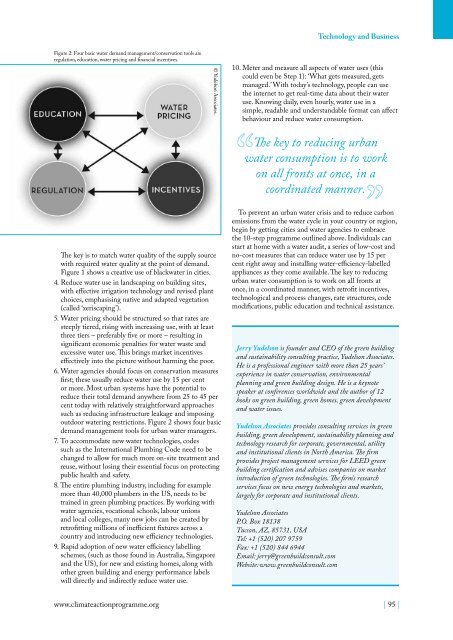Climate Action 2010-2011
Create successful ePaper yourself
Turn your PDF publications into a flip-book with our unique Google optimized e-Paper software.
Figure 2: Four basic water demand management/conservation tools are<br />
regulation, education, water pricing and financial incentives.<br />
© Yudelson Associates.<br />
Technology and Business<br />
10. Meter and measure all aspects of water uses (this<br />
could even be Step 1): ‘What gets measured, gets<br />
managed.’ With today’s technology, people can use<br />
the internet to get real-time data about their water<br />
use. Knowing daily, even hourly, water use in a<br />
simple, readable and understandable format can affect<br />
behaviour and reduce water consumption.<br />
The key to reducing urban<br />
water consumption is to work<br />
on all fronts at once, in a<br />
coordinated manner.<br />
The key is to match water quality of the supply source<br />
with required water quality at the point of demand.<br />
Figure 1 shows a creative use of blackwater in cities.<br />
4. Reduce water use in landscaping on building sites,<br />
with effective irrigation technology and revised plant<br />
choices, emphasising native and adapted vegetation<br />
(called ‘xeriscaping’).<br />
5. Water pricing should be structured so that rates are<br />
steeply tiered, rising with increasing use, with at least<br />
three tiers – preferably five or more – resulting in<br />
significant economic penalties for water waste and<br />
excessive water use. This brings market incentives<br />
effectively into the picture without harming the poor.<br />
6. Water agencies should focus on conservation measures<br />
first; these usually reduce water use by 15 per cent<br />
or more. Most urban systems have the potential to<br />
reduce their total demand anywhere from 25 to 45 per<br />
cent today with relatively straightforward approaches<br />
such as reducing infrastructure leakage and imposing<br />
outdoor watering restrictions. Figure 2 shows four basic<br />
demand management tools for urban water managers.<br />
7. To accommodate new water technologies, codes<br />
such as the International Plumbing Code need to be<br />
changed to allow for much more on-site treatment and<br />
reuse, without losing their essential focus on protecting<br />
public health and safety.<br />
8. The entire plumbing industry, including for example<br />
more than 40,000 plumbers in the US, needs to be<br />
trained in green plumbing practices. By working with<br />
water agencies, vocational schools, labour unions<br />
and local colleges, many new jobs can be created by<br />
retrofitting millions of inefficient fixtures across a<br />
country and introducing new efficiency technologies.<br />
9. Rapid adoption of new water efficiency labelling<br />
schemes, (such as those found in Australia, Singapore<br />
and the US), for new and existing homes, along with<br />
other green building and energy performance labels<br />
will directly and indirectly reduce water use.<br />
To prevent an urban water crisis and to reduce carbon<br />
emissions from the water cycle in your country or region,<br />
begin by getting cities and water agencies to embrace<br />
the 10-step programme outlined above. Individuals can<br />
start at home with a water audit, a series of low-cost and<br />
no-cost measures that can reduce water use by 15 per<br />
cent right away and installing water-efficiency-labelled<br />
appliances as they come available. The key to reducing<br />
urban water consumption is to work on all fronts at<br />
once, in a coordinated manner, with retrofit incentives,<br />
technological and process changes, rate structures, code<br />
modifications, public education and technical assistance.<br />
Jerry Yudelson is founder and CEO of the green building<br />
and sustainability consulting practice, Yudelson Associates.<br />
He is a professional engineer with more than 25 years’<br />
experience in water conservation, environmental<br />
planning and green building design. He is a keynote<br />
speaker at conferences worldwide and the author of 12<br />
books on green building, green homes, green development<br />
and water issues.<br />
Yudelson Associates provides consulting services in green<br />
building, green development, sustainability planning and<br />
technology research for corporate, governmental, utility<br />
and institutional clients in North America. The firm<br />
provides project management services for LEED green<br />
building certification and advises companies on market<br />
introduction of green technologies. The firm’s research<br />
services focus on new energy technologies and markets,<br />
largely for corporate and institutional clients.<br />
Yudelson Associates<br />
P.O. Box 18138<br />
Tucson, AZ, 85731, USA<br />
Tel: +1 (520) 207 9759<br />
Fax: +1 (520) 844 6944<br />
Email: jerry@greenbuildconsult.com<br />
Website: www.greenbuildconsult.com<br />
www.climateactionprogramme.org | 95 |












